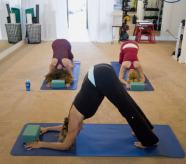Why Yoga Is So Good for You A Complete Guide
After thousands of studies and decades of practice, there’s no doubt that yoga is amazing for both body and mind. But if you’re new to yoga or just curious, you might still wonder: How exactly does yoga help? And why should you make it part of your life?

Finding your why for practicing yoga is important — it can give you motivation to roll out your mat regularly and help you track your progress in ways that feel meaningful.
Here’s a closer look at all the incredible ways yoga can help you heal, grow, and thrive.
1. Heals the Body
One of the biggest reasons people try yoga is its power to help the body heal itself. Loads of research shows that yoga can boost circulation, lower inflammation, activate your parasympathetic nervous system, and support your body’s natural ability to recover and stay healthy.
A regular yoga practice can help ease chronic pain and address common health issues like back pain, menopause symptoms, insomnia, high blood pressure, and arthritis.
[1]
2. Increases Flexibility
Modern life has us sitting way too much — which means our muscles, ligaments, and tendons tend to tighten and shorten over time. Yoga’s gentle stretches and deep breathing help muscles relax and release tension in the fascia (the connective tissue surrounding muscles).
Better flexibility means fewer injuries, greater range of motion, and everyday movements like bending, lifting, and twisting feel easier and more comfortable.
3. Builds Strong Muscles and Bones
Many yoga poses use your own body weight for resistance, which helps build strength and boost bone density. Strong muscles and bones are key for staying healthy as you age — they help prevent osteoporosis and reduce the risk of common injuries.
4. Improves Posture
Poor posture is a modern epidemic, thanks to all that sitting and screen time. Yoga helps by lengthening the spine, opening the chest, and strengthening the core muscles that support proper alignment.
Backbends and twists help realign the spine and release tightness in your back muscles. Many students find that over time they stand taller and experience less neck and shoulder strain. [2]
5. Balances and Regulates Emotions
One of yoga’s greatest gifts is teaching you how to pause, breathe, and respond mindfully — instead of reacting automatically when you’re triggered.
Practicing challenging poses and breathing through discomfort trains you to stay calm under stress. This helps you process emotions in healthier ways and over time, it builds emotional resilience so you can face challenges with more grace and steadiness.
6. Lifts Your Mood
Yoga isn’t just stretching — it’s a mood booster too! Moving your body and practicing deep breathing releases feel-good chemicals like endorphins that help you feel happy and relaxed.
Studies also show yoga raises levels of GABA, serotonin, and dopamine — key brain chemicals that regulate mood and lower anxiety and stress. [3]
7. Supports Mental Health
Yoga classes encourage self-acceptance, non-judgment, gratitude, and self-reflection — all of which can help you build a more positive outlook on life.
Joining a yoga community can create a sense of belonging and reduce loneliness and isolation. Yoga also strengthens your mind-body connection, sharpens self-awareness, clears mental clutter, and eases worry and anxiety. Together, these benefits can make a big difference for your overall mental well-being. [4]
8. Sharpens Focus and Concentration
Yoga takes focus — whether you’re holding a pose with proper alignment or flowing through a complex sequence. Inversions like headstands or shoulder stands increase blood and oxygen flow to your brain, which can boost alertness, awareness, and memory. [5]
Balancing poses such as Tree, Eagle, or Warrior III help train your focus by fixing your gaze on a single point — called a drishti — which hones concentration.
9. Promotes Rest and Relaxation
Our busy world rarely gives us moments of stillness. Yoga’s calming poses, breathwork, and meditation activate the parasympathetic nervous system — your body’s natural rest and renew mode.
This lowers stress hormones like cortisol and adrenaline, reduces heart rate and blood pressure, and helps you sink into a peaceful state of relaxation.
10. Creates a Sense of Community
Yoga classes build connection and belonging — something many of us crave in an increasingly digital world. Yoga studios often emphasize acceptance, compassion, and support, creating a safe space where you can feel seen and supported.
11. Deepens Relationships
Yoga is both an inner and outer practice. Breathwork, mindful movement, and self-reflection help you better understand yourself, while a regular practice also builds skills like listening, clear communication, compassion, awareness, and healthy coping — all of which can strengthen your relationships. [6]
12. Enhances Sexual Health
Yoga even has benefits for your sex life. It can increase stamina, improve circulation, and boost satisfaction for both partners. Hip-opening poses like Reclining Bound Angle, Happy Baby, Bridge, and Pigeon improve blood flow to the pelvic region — which supports healthy sexual function.
Better circulation can help men with erectile function and increase sensitivity and arousal for everyone. [7]
13. Improves Sleep Quality
A long-term yoga practice can help you sleep better and longer. Yoga reduces stress and anxiety — two of the biggest obstacles to good sleep — through asanas, breathing exercises (pranayama), and meditation.
An evening yoga session with gentle poses like Child’s Pose, Seated Forward Fold, and Supine Twist can calm your nervous system, release tension, and get your body ready for rest. Try pranayama like Alternate Nostril Breathing or Box Breathing before bed for even more relaxation. [8]
14. Supports Healthy Weight
Yoga can help with weight management by burning calories and building muscle, which raises your resting metabolic rate so you burn more calories even at rest.
The mindfulness you develop through yoga helps you notice your eating habits, tune into feelings of fullness, and make healthier food choices — which can help curb emotional eating and promote a balanced relationship wi
15. Boosts Energy
Unlike some workouts that leave you feeling wiped out, yoga usually leaves you feeling refreshed and revitalized. Many poses increase blood flow and deliver more oxygen and nutrients to your muscles and brain.
Different styles of yoga have different effects, but most practices help balance and unblock your body’s energy centers (chakras and nadis) — lifting your energy and mood.
16. Fosters Inner Peace
One of yoga’s ultimate goals is to reach a state of sattva — an inner calm and clarity that brings balance to your life. The gentle, soothing nature of yoga postures, breathing exercises, and meditation help calm your mind and create a deep sense of peace and harmony.

17. Encourages Gratitude
Gratitude naturally grows through yoga. By quieting your mind and replacing negative thoughts with more positive ones, you create space for gratitude to flourish. Many yoga teachers weave gratitude into their classes, helping students stay present and live with more intention.
FAQs
Q: How often should I practice yoga to see these benefits?
A: Even 2–3 times a week can make a difference. Consistency matters more than doing it perfectly!
Q: Do I need to be flexible to start yoga?
A: Not at all. Yoga helps you become more flexible — just start where you are.
Q: What style of yoga should I choose?
A: It depends! If you want to relax, try Yin or Restorative. For a workout, try Vinyasa or Power Yoga. For deep alignment, try Iyengar.
Q: Can yoga help with anxiety and depression?
A: Yes! Yoga’s breathwork, movement, and meditation help regulate mood, lower stress hormones, and boost brain chemicals that make you feel better.
Q: How long should my sessions be?
A: Anything from 10 to 60 minutes is great — even short sessions add up.
Table of Contents
Final Thoughts
No matter what brings you to your mat — pain relief, better sleep, stress relief, or simply wanting to feel good in your body — yoga has something for you.
Over time, your reasons for practicing might shift and grow — and that’s part of the journey. Listen to yourself, adjust as you go, and most importantly, enjoy the process.
If you have other reasons you love yoga, share them in the comments and inspire someone else to begin!
Recommended Reading
- Science of Yoga by Ann Swanson — A deep dive into the science behind yoga, blending modern research with ancient wisdom.
- Yoga for Cancer by Tari Prinster — Practical poses and insights for cancer survivors looking to heal and thrive.
- The Science of Yoga by William J. Broad — A balanced look at yoga’s real benefits and myths.
- Yoga for Osteoporosis by Loren Fishman, MD — A useful guide to safe, low-impact yoga for stronger bones.











